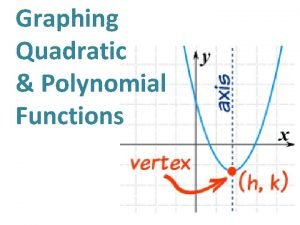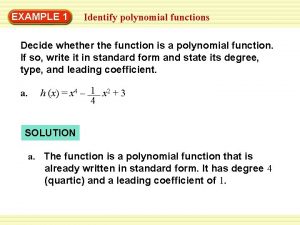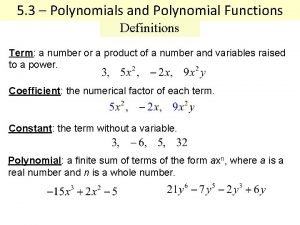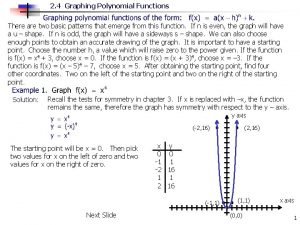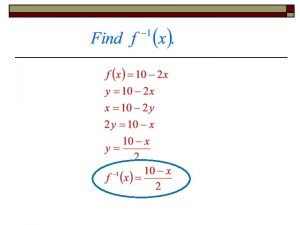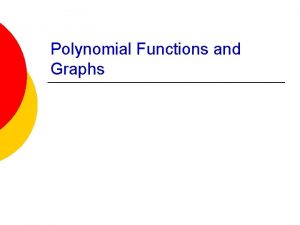Which of the following are polynomial functions no
































- Slides: 32

Which of the following are polynomial functions? no no yes

The Degree of a Function

What is the degree of the following functions?

The Leading Coefficient The polynomial function has a leading coefficient. Once the function is written in descending order of degree, the leading coefficient is the coefficient of the term with the highest degree.

Find the leading coefficient and degree of each polynomial function. Polynomial Function Leading Coefficient Degree

Basic Features of Graphs of Polynomial Functions. • A graph of a polynomial function is continuous. This means that the graph of a polynomial function has no breaks, holes or gaps.

Basic Features of Graphs of Polynomial Functions. • A graph of a polynomial function has only smooth, rounded turns. A polynomial function cannot have a sharp turn. Not a polynomial function

Graphs of Polynomial Functions

NOT GRAPHS OF A POLYNOMIAL FUNCTION

END BEHAVIOR OF POLYNOMIAL FUNCTIONS The behavior of the graph of a function to the far left and far right is called its end behavior. Although the graph of a polynomial function may have intervals where it increases or decreases, the graph will eventually rise or fall without bound as it moves far to the left or far to the right. How can we determine the end behavior of a polynomial function? We look only at the term with the highest degree.

The Leading Coefficient Test Look for the term with the highest degree. § Is the coefficient greater than or less than 0? § Is the exponent even or odd? The answers to these questions will help us to determine the end behavior of the polynomial function.

If the leading coefficient is positive with an even degree to its variable, the graph rises to the left and rises to the right ( , ). Example: f(x) = x²

If the leading coefficient is negative with an even degree to its variable, the graph falls to the left and falls to the right ( , ). Example: f(x) = − x²

If the leading coefficient is positive with an odd degree to its variable, the graph falls to the left and rises to the right ( , ). Example: f(x) = x³

If the leading coefficient is negative with an odd degree to its variable, the graph rises to the left and falls to the right ( , ). Example: f(x) = − x³

Using the Leading Coefficient Test If the leading coefficient is positive with an even degree to its variable, the graph rises to the left and rises to the right ( , ).

Using the Leading Coefficient Test Determine the end behavior of the graph of… f(x) = x³ + 3 x − 3 If the leading coefficient is positive with an odd degree to its variable, the graph falls to the left and rises to the right ( , ).

Using the Leading Coefficient Test Determine the end behavior of the graph of… f(x) = − 2 x³ + 3 x − 3 If the leading coefficient is negative with an odd degree to its variable, the graph rises to the left and falls to the right ( , ).

Using the Leading Coefficient Test If the leading coefficient is negative with an even degree to its variable, the graph falls to the left and falls to the right ( , ).

Using the Leading Coefficient Test Determine the end behavior of the graph of… f(x) = 3 x³(x − 1)(x + 5) Because these terms and expressions are each multiplied by each other, we add their degrees. 3+1+1=5 If the leading coefficient is positive with an odd degree to its variable, the graph falls to the left and rises to the right ( , ).

Using the Leading Coefficient Test Determine the end behavior of the graph of… f(x) = − 4 x³(x − 1)²(x + 5) Add the degrees If the leading coefficient is negative with an even degree to its variable, the graph falls to the left and falls to the right ( , ).

Zeros of Polynomial Functions • It can be shown that for a polynomial function of degree n, the following statements are true: • 1. The function has, at most, n real zeros. • 2. The graph has, at most, n – 1 turning points. • Turning points (relative maximum or relative minimum) are points at which the graph changes from increasing to decreasing or vice versa.

Zeros of Polynomial Functions The zeros of a polynomial function are the values of x which make f(x) = 0. These values are the roots, or solutions of the polynomial equation when y = 0. All real roots are the xintercepts of the graph. How many turning points does f(x) = x³ + 3 x² − x − 3 have? Find all the zeros of… f(x) = x³ + 3 x² − x − 3 Set up the equation: x³ + 3 x² − x − 3 = 0 and solve.

Is there a greatest common factor? No, so try grouping Place the greatest common factors in one set of parentheses. These two terms will be distributed over the other two terms. Find the greatest common factor of each set of parentheses Solve for zero

Find all the real zeros of f (x) = x 4 – x 3 – 2 x 2. How many turning points are there? Factor completely: f (x) = x 4 – x 3 – 2 x 2 = x 2(x + 1)(x – 2). y The real zeros are x = – 1, x = 0, and x = 2. (– 1, 0) These correspond to the x-intercepts. – 2 Check out the x-intercepts and the multiplicities. What happens? 2 (0, 0) x (2, 0) f (x) = x 4 – x 3 – 2 x 2

Multiplicities of Zeros The multiplicity of a zero is the number of times the real root of a polynomial function results in f(x) = 0. Example: solve for the zeros of f(x) = x² (x − 2)² = 0 x² = 0 therefore, x = 0 to the multiplicity of 2 (x − 2)² = 0 therefore x = 2 to the multiplicity of 2 The exponent tells us the multiplicity.

Multiplicity and x-intercepts Suppose r is a zero of even multiplicity. Then the graph touches the x-axis at r and turns around at r. Suppose r is a zero of odd multiplicity. Then the graph crosses the x-axis at r. Regardless of whether a multiplicity is even or odd, the graph tends to flatten out near zeros with a multiplicity greater than one.

Find the zeros of… f(x) = − 4(x + 2)² Give the multiplicity of each zero. State whether the graph crosses the x-axis or touches the x-axis and turns around at each zero.

The Intermediate Value Theorem Substitute 3 for every x in the function and simplify. Because our results have opposite signs, the function has a real zero between 2 and 3.

A strategy for graphing polynomial functions 1. Use the Leading Coefficient Test to determine the graph’s end behavior. 2. Find x-intercepts. 3. Find the y-intercept. Let x = 0. 4. Check for multiplicities. If the multiplicity is even, the graph touches the x-axis at r and turns around. If the multiplicity is odd, the graph touches the x-axis at r. The graph will flatten out near the x-intercept when the multiplicity is greater than one. 5. Use the fact that the maximum number of turning points of the graph is n − 1, where n is the degree of the polynomial function, to check whether it is drawn correctly. 6. Locate additional points.

Graphing a Polynomial Function Let’s graph the function f(x) = x³ + 3 x² − x − 3 What is it’s end behavior? If the leading coefficient is positive with an odd degree to its variable, the graph falls to the left and rises to the right ( , ). Find all the x-intercepts of… f(x) = x³ + 3 x² − x − 3 f(x) = (0)³ + (0)² − (0) − 3

Plot the x-intercepts, the y-intercept, and additional points between and beyond the x-intercepts. How many turning points does f(x) = x³ + 3 x² − x − 3 have? All of these zeros are to the multiplicity of one. What does the graph do at these intercepts? The graph passes through these intercepts. Sketch the graph.
 Antigentest åre
Antigentest åre Which of the following are polynomial functions?
Which of the following are polynomial functions? Polynomial end behavior chart
Polynomial end behavior chart Numpy.polynomial.polynomial
Numpy.polynomial.polynomial How to divide a polynomial by another polynomial
How to divide a polynomial by another polynomial Which of the following functions is a direct variation
Which of the following functions is a direct variation Which of the following functions is not a sinusoid
Which of the following functions is not a sinusoid Unit 5 homework 4 factoring polynomials
Unit 5 homework 4 factoring polynomials Structure in graphs of polynomial functions
Structure in graphs of polynomial functions 5-1 polynomial functions
5-1 polynomial functions Types of polynomials based on degree
Types of polynomials based on degree What is a leading term in polynomials
What is a leading term in polynomials I can recognize polynomial function yes or no
I can recognize polynomial function yes or no Investigating graphs of functions for their properties
Investigating graphs of functions for their properties Investigating graphs of functions for their properties
Investigating graphs of functions for their properties Polynomial standard form
Polynomial standard form Polynomial functions grade 12
Polynomial functions grade 12 Identifying polynomial functions
Identifying polynomial functions Polynomial expression standard form
Polynomial expression standard form Chapter 4 polynomial and rational functions
Chapter 4 polynomial and rational functions Chapter 3 polynomial and rational functions
Chapter 3 polynomial and rational functions Evaluation of polynomial function
Evaluation of polynomial function Transforming polynomial functions quiz part 2
Transforming polynomial functions quiz part 2 5-3 skills practice polynomial functions
5-3 skills practice polynomial functions What is the sign of the functions leading coefficient
What is the sign of the functions leading coefficient Transforming polynomial functions
Transforming polynomial functions 4-4 graphing polynomial functions
4-4 graphing polynomial functions What operations are polynomials closed under
What operations are polynomials closed under Polynomial function real life examples
Polynomial function real life examples Polynomial functions of higher degree
Polynomial functions of higher degree Investigating graphs of polynomial functions
Investigating graphs of polynomial functions Chapter 6 polynomials and polynomial functions
Chapter 6 polynomials and polynomial functions Solving word problems involving polynomial functions
Solving word problems involving polynomial functions















